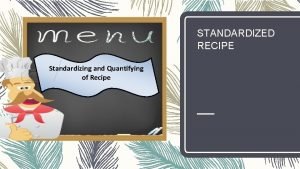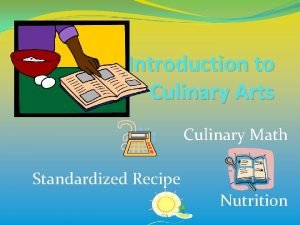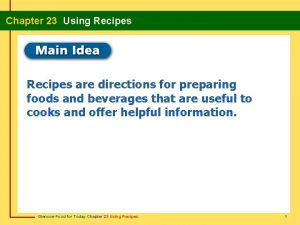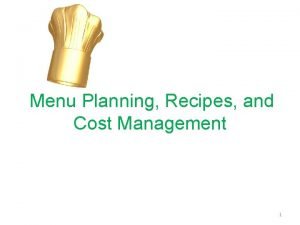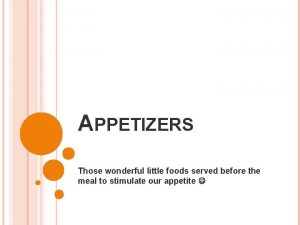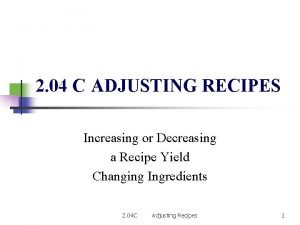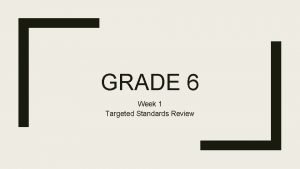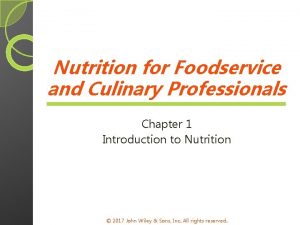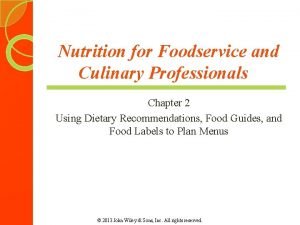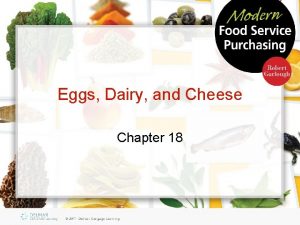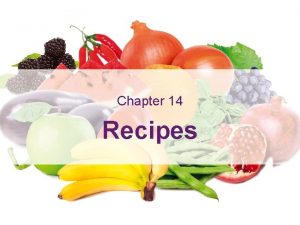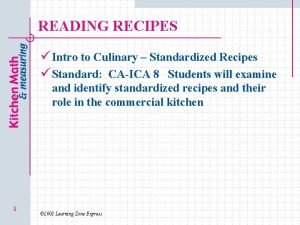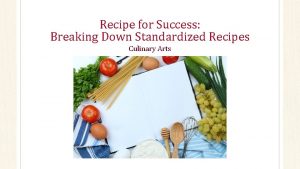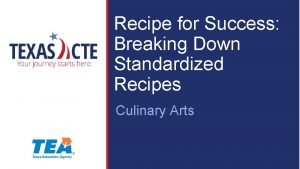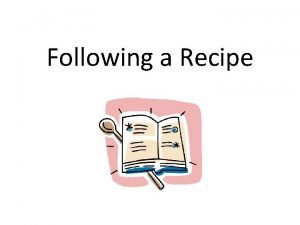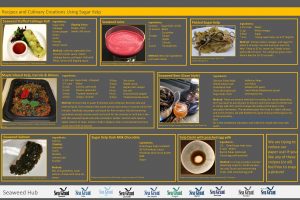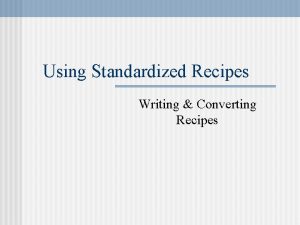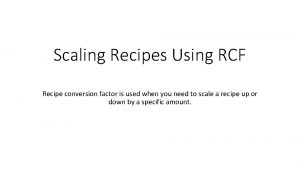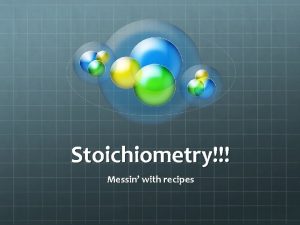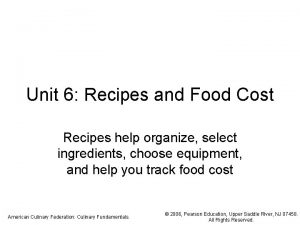Using a Recipe and Types of Recipes Culinary













- Slides: 13

Using a Recipe and Types of Recipes Culinary Basics LSHS

What is a good recipe? It gives clear, simple directions. n It gives the time and temperature for baking or cooking. n It has been tested. n It describes the dish clearly. n It uses exact measurements. n It gives the number it will serve. n


How do you use a recipe? Read recipe carefully and plan each step before starting to work. n Get your ingredients together first and collect all utensils needed. n Learn to measure accurately. Measure dry ingredients first, then liquids, then fats, and you will need only one cup or spoon. n

How do you use a recipe? (Continued) Keep working space cleaned and cooking dishes washed as you work. n Form good work habits in order to save time, energy, and materials. n Have the recipe in a place where it can be read easily, but will not be soiled. n

Recipes go wrong when: You fail to read the whole recipe first. n You measure inaccurately. n You misread terms, temperature, or ingredients. n You guess at something in a recipe. n You use the wrong method for mixing, or don’t mix completely. n

Recipes go wrong when: (Continued) n n n Your forget one ingredient. You use the wrong substitution for another ingredient. You divided the recipe wrong. You fail to blend ingredients at the correct temperature. You don’t used a tested recipe. You add something and then your lab partner adds it again.

Standard Form n The standard form – Gives all the ingredients first and then the method. – The listed ingredients show just what is needed to make the recipe. – The method follows in paragraphs or steps. – Especially good form for recipes using many ingredients. – +Easy to see ingredients needed – -Must look back and forth

Example of Standard Form ~ Scotch Shortbread ~ 1 cup butter n ¾ cup brown sugar n 2 ¼ cup sifted cake flour Cream butter and sugar together and work in flour. Chill. Roll out about ¼ inch think on lightly floured board. Cut with pastry wheel, small fancy cutters, or cut into diamonds. Bake in a slow oven 325 degrees. Makes 7. n

Narrative Form The Narrative Form • The form includes the amounts of the ingredients with the method. • It is especially good for short recipes. • Given in paragraph form • +Uses least amount of space • -Difficult to determine what ingredients are needed

Narrative Form ~ Chocolate Quickies ~ Melt 6 oz. Package of chocolate chips in 3 T. corn syrup and 1 T. water over low heat. Remove from heat. Stir in ¾ cup peanuts and ¾ cup raisins. Drop by teaspoonfuls on waxed paper on a cookie sheet. Chill until hardened. Makes 23 candies.

Action Form The Action Form n This recipe style combines narrative action with listed ingredients. n Form takes more space and is difficult to arrange economically or attractively on paper. n + It is easy to follow. n -Some steps are awkward

Action Form ~ Egg Nog ~ Beat together. . . 1 egg well beaten 2 T. sugar Beat in. . . 1 C. chilled rich milk ¼ tsp. Vanilla Serve cold in tall glass sprinkled lightly with nutmeg.
 How to create a standardized recipe
How to create a standardized recipe Math in culinary arts
Math in culinary arts Chapter 23 using recipes
Chapter 23 using recipes Standardized menu
Standardized menu Chapter 23 using recipes answer key
Chapter 23 using recipes answer key Menus recipes and cost management
Menus recipes and cost management Small open faced sandwiches served as appetizer
Small open faced sandwiches served as appetizer Increasing and decreasing recipes
Increasing and decreasing recipes Chris and jenny are comparing two similar punch recipes
Chris and jenny are comparing two similar punch recipes Nutrition for foodservice and culinary professionals
Nutrition for foodservice and culinary professionals Nutrition for foodservice and culinary professionals
Nutrition for foodservice and culinary professionals Nutrition for foodservice and culinary professionals
Nutrition for foodservice and culinary professionals Culinary crossword 9.1 eggs and dairy
Culinary crossword 9.1 eggs and dairy Ulcerative colitis diet
Ulcerative colitis diet
